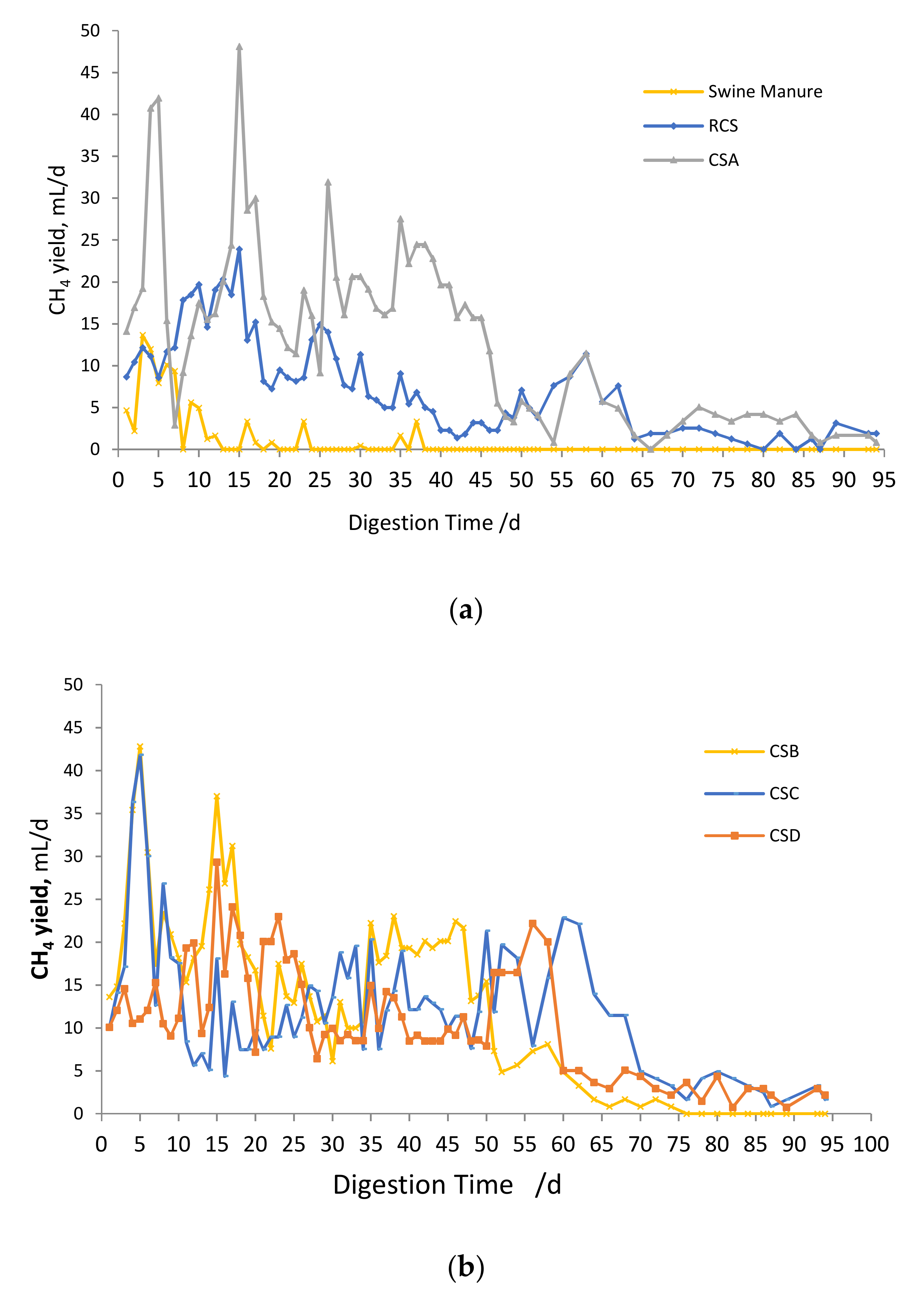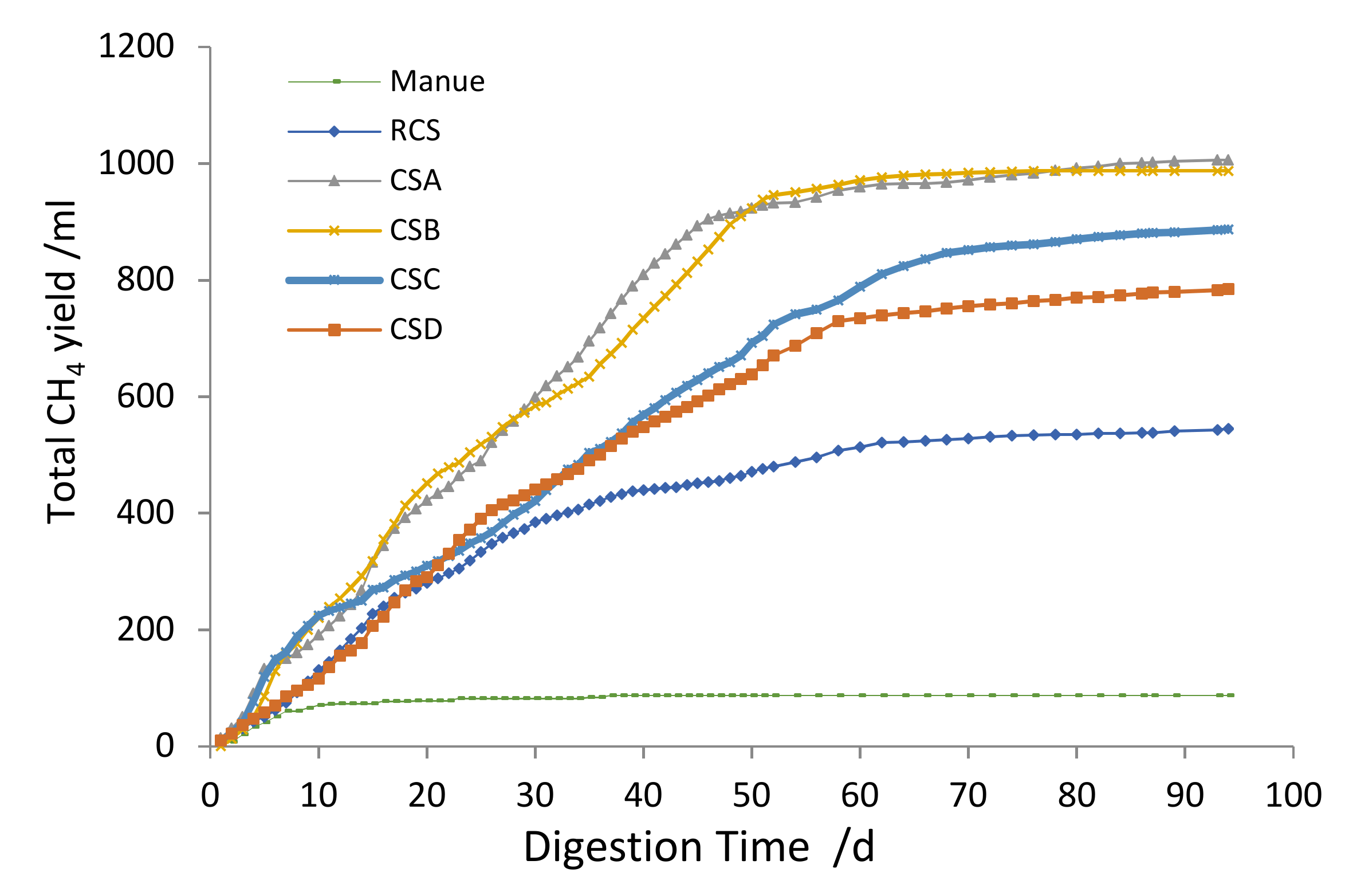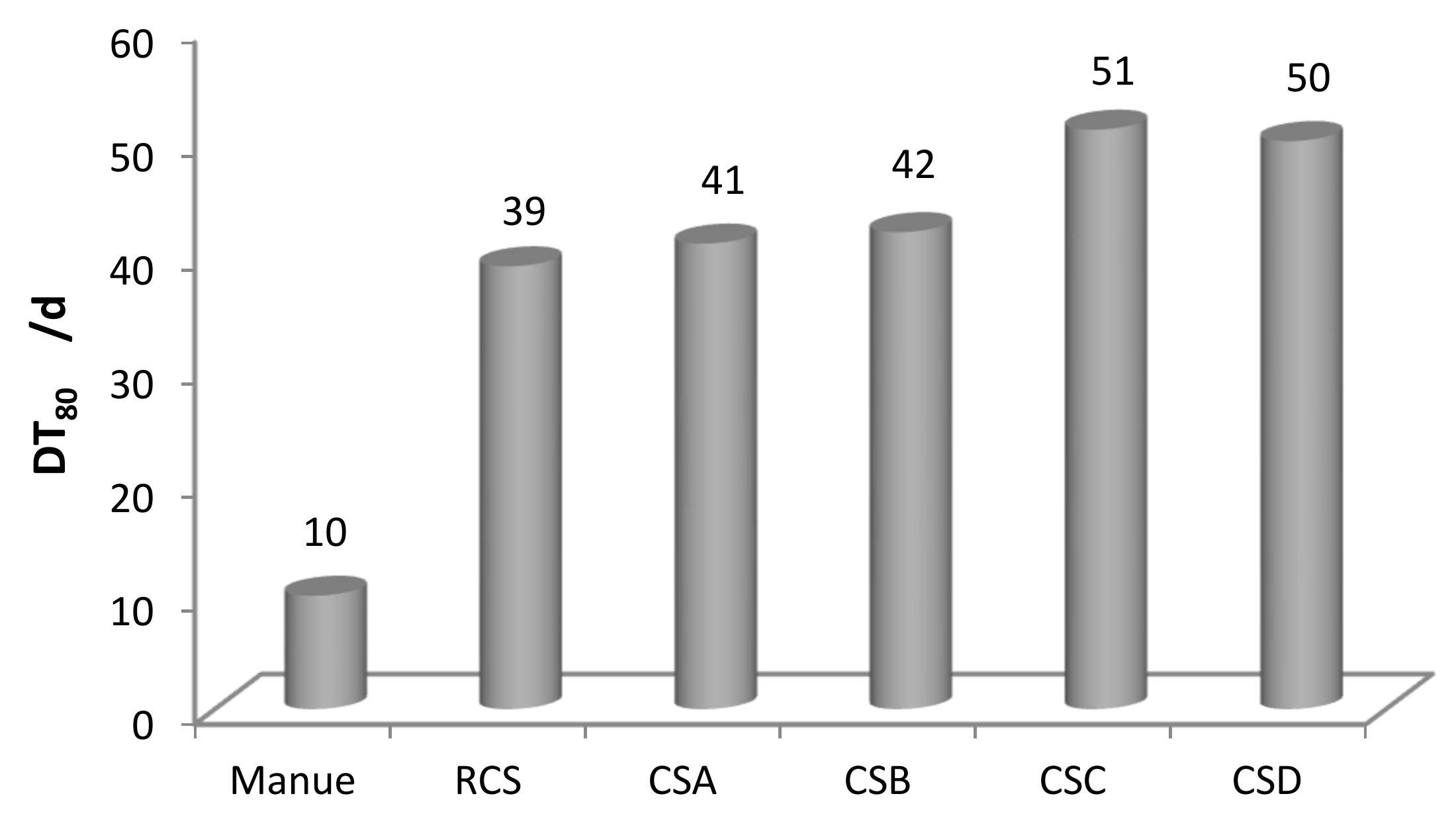Effects of Corn Stover Pretreated with NaOH and CaO on Anaerobic Co-Digestion of Swine Manure and Corn Stover
Abstract
1. Introduction
2. Experimental Section
2.1. Materials
2.2. Pretreatment
2.3. Digestion
2.4. Analytical Procedures
2.5. Energy and Cost Analysis
3. Results and Discussion
3.1. Effect of Pretreatment Using Alkaline
3.2. Anaerobic Co-Digestion.
3.3. Digestion Time (DT80)
3.4. Reducing Sugar and Lignin Content of CS after Digesting
3.5. Cost-Efficiency Analysis
4. Conclusions
Authors Contribution
Acknowledgments
Conflicts of Interest
References
- Zhang, R.; Liu, F.; Liu, H.; Zhang, D. Pretreatment of Corn Stover with Diluted Nitric Acid for the Enhancement of Acidogenic Fermentation. Energy Fuel. 2018, 32, 425–430. [Google Scholar] [CrossRef]
- Yang, M.; Rehman, M.S.U.; Yan, T.; Khan, A.U.; Oleskowicz-Popiel, P.; Xu, X.; Cui, P.; Xu, J. Treatment of different parts of corn stover for high yield and lower polydispersity lignin extraction with high-boiling alkaline solvent. Bioresour. Technol. 2018, 249, 737–743. [Google Scholar] [CrossRef] [PubMed]
- Zhao, Y.; Damgaard, A.; Christensen, T.H. Bioethanol from corn stover—A review and technical assessment of alternative biotechnologies. Prog. Energy Combust. 2018, 67, 275–291. [Google Scholar] [CrossRef]
- Kiran, L.K.; James, D.M. Availability of corn stover as a sustainable feedstock for bioethanol production. Bioresour. Technol. 2003, 88, 17–25. [Google Scholar]
- Liu, C.M.; Wachemo, A.C.; Yuan, H.R.; Zou, D.X.; Liu, Y.P.; Zhang, L.; Pang, Y.Z.; Li, X.J. Evaluation of methane yield using acidogenic effluent of NaOH pretreated corn stover in anaerobic digestion. Renew. Energy 2018, 116, 224–233. [Google Scholar] [CrossRef]
- Weiland, P. Biogas production: Current state and perspectives. Appl. Microbiol. Biot. 2010, 85, 849–860. [Google Scholar] [CrossRef] [PubMed]
- Cheng, J.J.; Timilsina, G.R. Status and barriers of advanced biofuel technologies: A review. Renew. Energy 2011, 36, 3541–3549. [Google Scholar] [CrossRef]
- Mouthier, T.; Appeldoorn, M.M.; Pel, H.; Schols, H.A.; Gruppen, H.; Kabel, M.A. Corn stover lignin is modified differently by acetic acid compared to sulfuric acid. Ind. Crop. Prod. 2018, 121, 160–168. [Google Scholar] [CrossRef]
- Qiao, X.; Zhao, C.; Shao, Q.; Hassan, M. Structural Characterization of Corn Stover Lignin after Hydrogen Peroxide Presoaking Prior to Ammonia Fiber Expansion Pretreatment. Energy Fuel. 2018, 32, 6022–6030. [Google Scholar] [CrossRef]
- Jaramillo, I.; Sanchez, A. Mass Flow Dynamic Modeling and Residence Time Control of a Continuous Tubular Reactor for Biomass Pretreatment. ACS Sustain. Chem. Eng. 2018, 6, 8570–8577. [Google Scholar] [CrossRef]
- An, S.; Li, W.; Liu, Q.; Xia, Y.; Zhang, T.; Huang, F.; Lin, Q.; Chen, L. Combined dilute hydrochloric acid and alkaline wet oxidation pretreatment to improve sugar recovery of corn stover. Bioresour. Technol. 2019, 271, 283–288. [Google Scholar] [CrossRef] [PubMed]
- Li, X.; Li, L.; Zheng, M.; Fu, G.; Lar, J.S. Anaerobic Co-Digestion of Cattle Manure with Corn Stover Pretreated by Sodium Hydroxide for Efficient Biogas Production. Energy Fuel. 2009, 23, 4635–4639. [Google Scholar] [CrossRef]
- Li, J.; Lu, M.; Guo, X.; Zhang, H.; Li, Y.; Han, L. Insights into the improvement of alkaline hydrogen peroxide (AHP) pretreatment on the enzymatic hydrolysis of corn stover: Chemical and microstructural analyses. Bioresour. Technol. 2018, 265, 1–7. [Google Scholar] [CrossRef] [PubMed]
- Xu, H.; Li, B.; Mu, X. A review of alkali-based pretreatment to enhance enzymatic saccharification for lignocellulosic biomass conversion. Ind. Eng. Chem. Res. 2016, 55, 8691–8705. [Google Scholar] [CrossRef]
- Meng, X.; Sun, Q.; Kosa, M.; Huang, F.; Pu, Y.; Ragauskas, A.J. Physicochemical Structural Changes of Poplar and Switchgrass during Biomass Pretreatment and Enzymatic Hydrolysis. ACS Sustain. Chem. Eng. 2016, 4, 4563–4572. [Google Scholar] [CrossRef]
- Jensen, M.M.; Djajadi, D.T.; Torri, C.; Rasmussen, H.B.; Madsen, R.B.; Venturini, E.; Vassura, I.; Becker, J.; Iversen, B.B.; Meyer, A.S.; et al. Hydrothermal Liquefaction of Enzymatic Hydrolysis Lignin: Biomass Pretreatment Severity Affects Lignin Valorization. ACS Sustain. Chem. Eng. 2018, 6, 5940–5949. [Google Scholar] [CrossRef]
- Bhalla, A.; Bansal, N.; Pattathil, S.; Li, M.; Shen, W.; Particka, C.A.; Karlen, S.D.; Phongpreecha, T.; Semaan, R.R.; Gonzales-Vigil, E.; et al. Engineered Lignin in Poplar Biomass Facilitates Cu-Catalyzed Alkaline-Oxidative Pretreatment. ACS Sustain. Chem. Eng. 2018, 6, 2932–2941. [Google Scholar] [CrossRef]
- Liu, H.; Pang, B.; Zhao, Y.; Lu, J.; Han, Y.; Wang, H. Comparative study of two different alkali-mechanical pretreatments of corn stover for bioethanol production. Fuel 2018, 221, 21–27. [Google Scholar] [CrossRef]
- Karp, E.M.; Donohoe, B.S.; Brien, M.H.O.; Ciesielski, P.N.; Mittal, A.; Biddy, M.J.; Beckham, G.T. Alkaline Pretreatment of Corn Stover: Bench-Scale Fractionation and Stream Characterization. ACS Sustain. Chem. Eng. 2014, 2, 1481–1491. [Google Scholar] [CrossRef]
- Kumar, A.K.; Sharma, S. Recent updates on different methods of pretreatment of lignocellulosic feedstocks: A review. Bioresour. Bioprocess. 2017, 4, 7. [Google Scholar] [CrossRef]
- Cuvilas, C.A.; Yang, W. Spruce Pretreatment for Thermal Application: Water, Alkaline, and Diluted Acid Hydrolysis. Energy Fuel 2012, 26, 6426–6431. [Google Scholar] [CrossRef]
- Li, J.; Zhang, M.; Li, J.; Wang, D. Corn stover pretreatment by metal oxides for improving lignin removal and reducing sugar degradation and water usage. Bioresour. Technol. 2018, 263, 232–241. [Google Scholar] [CrossRef] [PubMed]
- You, Z.; Wei, T.; Cheng, J.J. Improving Anaerobic Codigestion of Corn Stover Using Sodium Hydroxide Pretreatment. Energy Fuel 2014, 28, 549–555. [Google Scholar] [CrossRef]
- Zhu, J.; Wan, C.; Li, Y. Enhanced solid-state anaerobic digestion of corn stover by alkaline pretreatment. Bioresour. Technol. 2010, 101, 7523–7528. [Google Scholar] [CrossRef] [PubMed]
- Yuan, W.; Gong, Z.; Wang, G.; Zhou, W.; Liu, Y.; Wang, X.; Zhao, M. Alkaline organosolv pretreatment of corn stover for enhancing the enzymatic digestibility. Bioresour. Technol. 2018, 265, 464–470. [Google Scholar] [CrossRef] [PubMed]
- Fang, S.; Wang, W.; Tong, S.; Zhang, C.; Liu, P. Evaluation of the Effects of Isolated Lignin on Cellulose Enzymatic Hydrolysis of Corn Stover Pretreatment by NaOH Combined with Ozone. Molecules 2018, 23, 1495. [Google Scholar] [CrossRef] [PubMed]
- Mustafa, A.M.; Li, H.; Radwan, A.A.; Sheng, K.; Chen, X. Effect of hydrothermal and Ca(OH)2 pretreatments on anaerobic digestion of sugarcane bagasse for biogas production. Bioresour. Technol. 2018, 259, 54–60. [Google Scholar] [CrossRef] [PubMed]
- Bruni, E.; Jensen, A.P.; Angelidaki, I. Comparative study of mechanical, hydrothermal, chemical and enzymatic treatments of digested biofibers to improve biogas production. Bioresour. Technol. 2010, 101, 8713–8717. [Google Scholar] [CrossRef] [PubMed]
- Gu, Y.; Zhang, Y.; Zhou, X. Effect of Ca(OH)2 pretreatment on extruded rice straw anaerobic digestion. Bioresour. Technol. 2015, 196, 116–122. [Google Scholar] [CrossRef] [PubMed]
- Kurian, J.K.; Gariepy, Y.; Lefsrud, M.; Orsat, V.; Seguin, P.; Yaylayan, V.; Raghavan, G.S.V. Experimental Study on Calcium Hydroxide-Assisted Delignification of Hydrothermally Treated Sweet Sorghum Bagasse. Int. J. Chem. Eng. 2014, 2014, 1–9. [Google Scholar] [CrossRef]
- Kim, S.; Holtzapple, M.T. Lime pretreatment and enzymatic hydrolysis of corn stover. Bioresour. Technol. 2005, 96, 1994–2006. [Google Scholar] [CrossRef] [PubMed]
- Malmierca, S.; Díez-Antolínez, R.; Paniagua, A.I.; Martín, M. Technoeconomic Study of Biobutanol AB Production. 1. Biomass Pretreatment and Hydrolysis. Ind. Eng. Chem. Res. 2017, 56, 1518–1524. [Google Scholar] [CrossRef]
- Zhang, X.; Xu, J.; Cheng, J.J. Pretreatment of Corn Stover for Sugar Production with Combined Alkaline Reagents. Energy Fuel 2011, 25, 4796–4802. [Google Scholar] [CrossRef]
- Xu, J.; Cheng, J.J. Pretreatment of switchgrass for sugar production with the combination of sodium hydroxide and lime. Bioresour. Technol. 2011, 102, 3861–3868. [Google Scholar] [CrossRef] [PubMed]
- Xu, J.; Cheng, J.J.; Sharma-Shivappa, R.R.; Burns, J.C. Lime pretreatment of switchgrass at mild temperatures for ethanol production. Bioresour. Technol. 2010, 101, 2900–2903. [Google Scholar] [CrossRef] [PubMed]
- Wang, Z.; Cheng, J.J. Lime Pretreatment of Coastal Bermudagrass for Bioethanol Production. Energy Fuel 2011, 25, 1830–1836. [Google Scholar] [CrossRef]
- Dahadha, S.; Amin, Z.; Lakeh, A.A.B.; Elbeshbishy, E. Evaluation of Different Pretreatment Processes of Lignocellulosic Biomass for Enhanced Biomethane Production. Energy Fuel 2017, 31, 10335–10347. [Google Scholar] [CrossRef]
- Hassan, M.; Umar, M.; Mamat, T.; Muhayodin, F.; Talha, Z.; Mehryar, E.; Ahmad, F.; Ding, W.; Zhao, C. Methane Enhancement through Sequential Thermochemical and Sonication Pretreatment for Corn Stover with Anaerobic Sludge. Energy Fuel 2017, 31, 6145–6153. [Google Scholar] [CrossRef]
- Kuhn, E.M.; O’Brien, M.H.; Ciesielski, P.N.; Schell, D.J. Pilot-Scale Batch Alkaline Pretreatment of Corn Stover. ACS Sustain. Chem. Eng. 2015, 4, 944–956. [Google Scholar] [CrossRef]
- Jiang, D.; Ge, X.; Zhang, Q.; Zhou, X.; Chen, Z.; Keener, H.; Li, Y. Comparison of sodium hydroxide and calcium hydroxide pretreatments of giant reed for enhanced enzymatic digestibility and methane production. Bioresour. Technol. 2017, 244, 1150–1157. [Google Scholar] [CrossRef] [PubMed]
- Kumar, D.; Murthy, G.S. Impact of pretreatment and downstream processing technologies on economics and energy in cellulosic ethanol production. Biotechnol. Biofuels 2011, 4, 2–19. [Google Scholar] [CrossRef] [PubMed]
- Liu, C.; Wachemo, A.C.; Tong, H.; Shi, S.; Zhang, L.; Yuan, H.; Li, X. Biogas production and microbial community properties during anaerobic digestion of corn stover at different temperatures. Bioresour. Technol. 2018, 261, 93–103. [Google Scholar] [CrossRef] [PubMed]
- Yu, H.; Min, Z.; Jia, O.; Yang, S. Comparative Study on Four Chemical Pretreatment Methods for an Efficient Saccharification of Corn Stover. Energy Fuel 2014, 28, 4282–4287. [Google Scholar] [CrossRef]
- Mittal, A.; Katahira, R.; Donohoe, B.S.; Black, B.A.; Pattathil, S.; Stringer, J.M.; Beckham, G.T. Alkaline Peroxide Delignification of Corn Stover. ACS Sustain. Chem. Eng. 2017, 5, 6310–6321. [Google Scholar] [CrossRef]
- Mittal, A.; Katahira, R.; Donohoe, B.S.; Pattathil, S.; Kandemkavil, S.; Reed, M.L.; Biddy, M.J.; Beckham, G.T. Ammonia Pretreatment of Corn Stover Enables Facile Lignin Extraction. ACS Sustain. Chem. Eng. 2017, 5, 2544–2561. [Google Scholar] [CrossRef]
- Bali, G.; Meng, X.; Deneff, J.I.; Sun, Q.; Ragauskas, A.J. The Effect of Alkaline Pretreatment Methods on Cellulose Structure and Accessibility. ChemSusChem 2015, 8, 275–279. [Google Scholar] [CrossRef]
- Thomas, H.; Seira, J.; Escudié, R.; Carrère, H. Lime Pretreatment of Miscanthus: Impact on BMP and Batch Dry Co-Digestion with Cattle Manure. Molecules 2018, 23, 1608. [Google Scholar] [CrossRef]
- Li, Y.; Zhang, R.; He, Y.; Liu, X.; Chen, C.; Liu, G. Thermophilic Solid-State Anaerobic Digestion of Alkaline-Pretreated Corn Stover. Energy Fuel 2014, 28, 3759–3765. [Google Scholar] [CrossRef]
- Li, L.; Yang, X.; Li, X.; Zheng, M.; Chen, J.; Zhang, Z. The influence of inoculum sources on anaerobic biogasification of NaOH-treated corn stover. Energy Sources Part A Recovery Util. Environ. Eff. 2011, 33, 138–144. [Google Scholar] [CrossRef]
- Zheng, M.; Li, L.; Li, X.; Xiong, J.; Mei, T. The effects of alkaline pretreatment parameters on anaerobic biogasification of corn stover. Energy Sources Part A Recovery Util. Environ. Eff. 2010, 32, 1918–1925. [Google Scholar] [CrossRef]
- Zheng, M.X.; Li, X.J.; Li, L.Q.; Yang, X.J.; He, Y.F. Enhancing anaerobic biogasification of corn stover through wet state NaOH pretreatment. Bioresour. Technol. 2009, 100, 5140–5145. [Google Scholar] [CrossRef] [PubMed]
- Pang, Y.Z.; Liu, Y.P.; Li, X.J.; Wang, K.S.; Yuan, H.R. Improving Biodegradability and Biogas Production of Corn Stover through Sodium Hydroxide Solid State Pretreatment. Energy Fuel 2008, 22, 2761–2766. [Google Scholar] [CrossRef]
- Solé-Bundó, M.; Carrère, H.; Garfí, M.; Ferrer, I. Enhancement of microalgae anaerobic digestion by thermo-alkaline pretreatment with lime (CaO). Algal Res. 2017, 24, 199–206. [Google Scholar] [CrossRef]
- Wang, Z.; Xu, J.; Pandey, P.; Cheng, J.J.; Li, R.; Qu, R. Improvement of Sugar Production from Transgenic Switchgrass with Low-Temperature Alkali Pretreatment. Energy Fuel 2012, 26, 3054–3061. [Google Scholar] [CrossRef]
- Qu, T.; Zhang, X.; Gu, X.; Han, L.; Ji, G.; Chen, X.; Xiao, W. Ball Milling for Biomass Fractionation and Pretreatment with Aqueous Hydroxide Solutions. ACS Sustain. Chem. Eng. 2017, 5, 7733–7742. [Google Scholar] [CrossRef]
- Gong, W.; Liu, C.; Mu, X.; Du, H.; Lv, D.; Li, B.; Han, S. Hydrogen Peroxide-Assisted Sodium Carbonate Pretreatment for the Enhancement of Enzymatic Saccharification of Corn Stover. ACS Sustain. Chem. Eng. 2015, 3, 3477–3485. [Google Scholar] [CrossRef]






| Property | CS | Swine Manure | Inoculum |
|---|---|---|---|
| MLSS a, g/L | ND e | ND | 17.5 ± 1.0 |
| TC b, % | 29.9 ± 0.42 | 0.13 ± 0.02 | 0.31 ± 0.03 |
| TKN c, % | 0.53 ± 0.04 | 0.05 ± 0.01 | 0.06 ± 0.01 |
| Reduced sugar, % | 50.7 ± 1.21 | ND | ND |
| Lignin, % | 23.7 ± 1.05 | ND | ND |
| NH4, mg/L | ND | 166 ± 11.5 | 161 ± 7.4 |
| COD d, mg/L | ND | 8980 ± 83 | 16,140 ± 94 |
| Dose | NaOH and CaO Loading, g/g CS | ||||
|---|---|---|---|---|---|
| 0 | 0.10 + 0.00 | 0.075 + 0.05 | 0.05 + 0.05 | 0.025 + 0.10 | |
| RCS | Treat-CSA | Treat-CSB | Treat-CSC | Treat-CSD | |
| Lignin, content, % | 23.7 ± 0.23 | 13.2 ± 0.48 | 13.1 ± 0.17 | 16.1 ± 0.22 | 17.8 ± 0.87 |
| Removal efficiency, a% | 0.00 ± 0.01 | 44.5 ± 2.11 | 44.6 ± 0.75 | 32.0 ± 0.97 | 24.8 ± 3.83 |
| CS recovery, b % | 94.9 | 72.0 ± 1.14 | 73.1 ± 0.08 | 78.3 ± 2.01 | 81.6 ± 1.21 |
| Chemical Loading Rate (g/g) | CH4/Corn Stover (mL/g VS) | Gross Biomass Energy Production (kJ/kg TS) | Benefit of Electricity Generation ($/ton TS) | Revenue due to Pretreat-ment ($/ton TS) | Cost for NaOH Input ($/ton TS) | Cost for CaO Input ($/ton TS) | Net Benefit from Pretreatment ($/ton TS) |
|---|---|---|---|---|---|---|---|
| RCS | 237 | 4690 | 137 | 0 | |||
| Treat-CSA 0.1 NaOH | 328 | 6170 | 180 | 43.0 | 45.0 | 0.0 | –2.0 |
| Treat-CSB 0.75 NaOH + 0.05 CaO | 322 | 6040 | 176 | 39.0 | 33.8 | 3.6 | 1.9 |
| Treat-CSC 0.05 NaOH + 0.05 CaO | 286 | 5370 | 156 | 19.7 | 22.5 | 3.6 | –6.4 |
| Treat-CSD 0.025 NaOH + 0.1 CaO | 249 | 4680 | 136 | –0.38 | 11.3 | 7.2 | –18.8 |
© 2018 by the authors. Licensee MDPI, Basel, Switzerland. This article is an open access article distributed under the terms and conditions of the Creative Commons Attribution (CC BY) license (http://creativecommons.org/licenses/by/4.0/).
Share and Cite
You, Z.; Zhang, S.; Kim, H.; Chiang, P.-C.; Sun, Y.; Guo, Z.; Xu, H. Effects of Corn Stover Pretreated with NaOH and CaO on Anaerobic Co-Digestion of Swine Manure and Corn Stover. Appl. Sci. 2019, 9, 123. https://doi.org/10.3390/app9010123
You Z, Zhang S, Kim H, Chiang P-C, Sun Y, Guo Z, Xu H. Effects of Corn Stover Pretreated with NaOH and CaO on Anaerobic Co-Digestion of Swine Manure and Corn Stover. Applied Sciences. 2019; 9(1):123. https://doi.org/10.3390/app9010123
Chicago/Turabian StyleYou, Zhaoyang, Shujuan Zhang, Hyunook Kim, Pen-Chi Chiang, Yonjun Sun, Ziyang Guo, and Haiyang Xu. 2019. "Effects of Corn Stover Pretreated with NaOH and CaO on Anaerobic Co-Digestion of Swine Manure and Corn Stover" Applied Sciences 9, no. 1: 123. https://doi.org/10.3390/app9010123
APA StyleYou, Z., Zhang, S., Kim, H., Chiang, P.-C., Sun, Y., Guo, Z., & Xu, H. (2019). Effects of Corn Stover Pretreated with NaOH and CaO on Anaerobic Co-Digestion of Swine Manure and Corn Stover. Applied Sciences, 9(1), 123. https://doi.org/10.3390/app9010123








